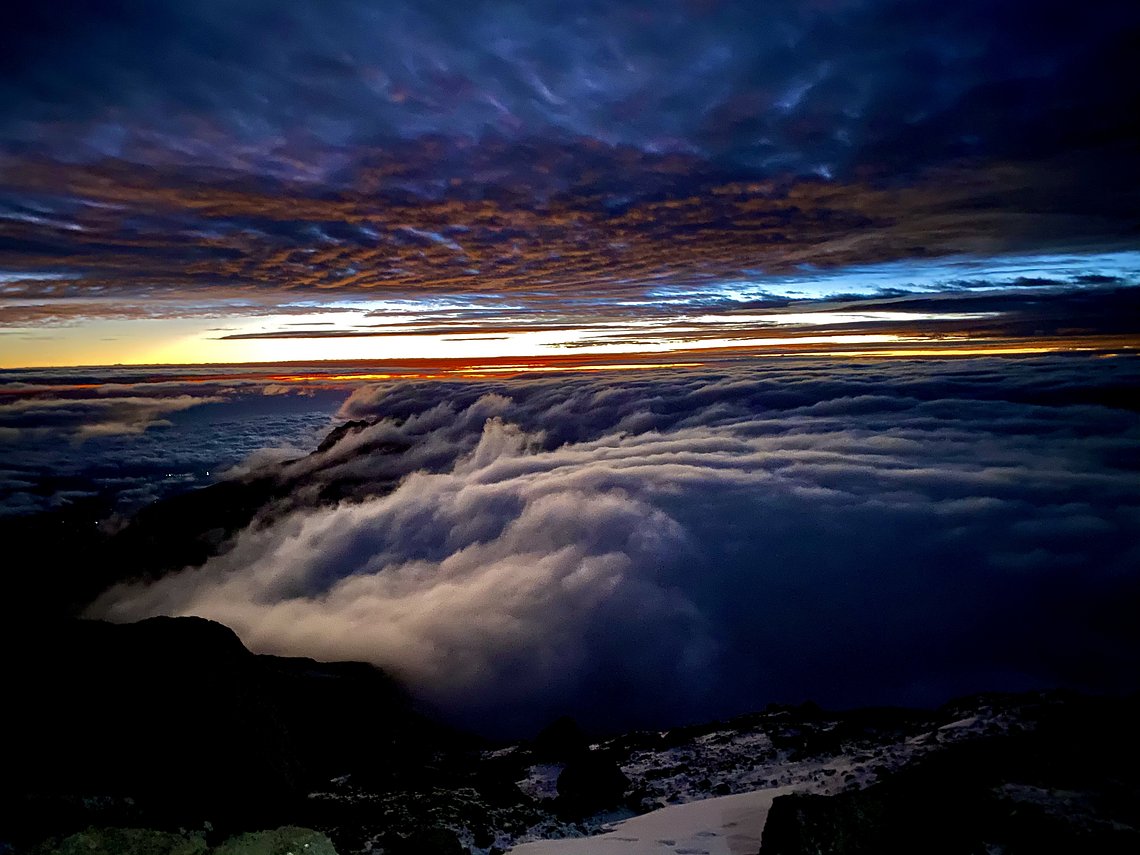Understanding the weather and elements on Kilimanjaro
Helping you to be prepared...

Posted on Thu 3 Aug 2023 · by Jason Rawles
Mount Kilimanjaro, rising majestically over the East African savannah, is a formidable and alluring challenge for climbers worldwide. As the highest freestanding mountain on the planet, its weather patterns play a crucial role in determining the success and safety of those attempting to reach its snow-capped summit. In this blog, we will explore the diverse and unique weather conditions that one can encounter on Kilimanjaro, helping climbers better prepare for their once-in-a-lifetime ascent.
Geographic Location and Climate Zones
Kilimanjaro's location near the equator gives rise to its diverse microclimates. The mountain's height and proximity to the Indian Ocean further influence its weather patterns. It is essential to understand the various climate zones encountered during the climb:
1.1. Cultivation Zone (800m to 1800m)
At the mountain's base, the cultivation zone experiences a warm and humid tropical climate. Lush farmlands and dense vegetation thrive here, featuring bananas, coffee, and various other crops.
1.2. Rainforest Zone (1800m to 2800m)
As climbers ascend, they enter the lush rainforest zone. This region receives considerable rainfall, with average temperatures ranging from 10°C to 20°C (50°F to 68°F). The abundant vegetation is characterised by towering trees, moss-covered branches, and exotic birdlife.
1.3. Heath and Moorland Zone (2800m to 4000m)
The heath and moorland zone boasts a cooler and drier climate, with temperatures ranging from 5°C to 15°C (41°F to 59°F). Unique flora, including giant groundsel and lobelias, thrive in this surreal landscape.
1.4. Alpine Desert Zone (4000m to 5000m)
The alpine desert zone is a barren and rocky expanse, where temperatures range from 0°C to 10°C (32°F to 50°F). At this altitude, vegetation is sparse, and climbers may experience significant changes in weather during their trek.
1.5. Arctic Zone (5000m and above)
The Arctic zone, also known as the summit zone, is the coldest region on Kilimanjaro. Daytime temperatures hover around -5°C to -10°C (23°F to 14°F), and night temperatures can plummet well below freezing.
The influence of Seasons on Weather
The weather on Kilimanjaro is influenced by distinct climbing seasons, each with its unique characteristics. Understanding these seasons is crucial for planning a successful climb:
2.1. Dry Season (January to March and June to October)
The dry season is the most popular time to climb Kilimanjaro. From January to March and June to October, the weather is relatively stable, with less rainfall and clear skies. This period offers excellent visibility, making it easier to admire the stunning landscape.
2.2. Wet Season (April to May and November to December)
The wet season brings heavy rainfall and cloudy conditions to Kilimanjaro. April to May and November to December witness increased precipitation, resulting in slippery trails and challenging climbing conditions. However, some adventurers choose this season for a quieter and more unique experience on the mountain.
Rain and Precipitation
Rainfall is a significant factor in Kilimanjaro's weather. It impacts the trails, affects visibility, and can lead to challenging conditions during the climb. The rainiest months are April, May, and November, while the driest months are January and February. Climbers should be prepared for sudden weather changes and pack appropriate rain gear.
Temperature Variations at Different Altitudes
Climbers on Kilimanjaro encounter diverse temperature fluctuations as they ascend. The key to a successful summit is understanding how temperatures change at various altitudes:
4.1. Base to 3000m
At lower altitudes, temperatures are relatively warm, ranging from 20°C to 25°C (68°F to 77°F) during the day.
4.2. 3000m to 5000m
As climbers ascend into higher elevations, temperatures begin to drop significantly. At 3000m, temperatures range from 10°C to 15°C (50°F to 59°F), and at 5000m, daytime temperatures can hover around freezing.
4.3. 5000m and Above
In the summit zone, temperatures plunge well below freezing during both day and night, averaging around -5°C to -10°C (23°F to 14°F).
Wind and Its Impact
Strong winds are common on Kilimanjaro, especially at higher elevations. Windchill can exacerbate the already cold temperatures, making proper windproof clothing a necessity. Gusty winds can also affect visibility and stability on exposed sections of the climb.
Snow and Ice
At higher altitudes, climbers may encounter snow and ice, especially during the dry season. The glaciers on Kilimanjaro have been shrinking due to climate change, but ice can still present challenges on certain routes. Climbers must be equipped with appropriate gear and be cautious on icy sections (route dependant).
Altitude Sickness and Weather
Kilimanjaro's weather and altitude are closely linked, as the lower temperatures at higher altitudes increase the risk of altitude sickness. Climbers must acclimatise properly (link to a blog about acclimatising), pace themselves, and be aware of the potential effects of high altitude on their bodies.
Climbing Kilimanjaro is a once-in-a-lifetime adventure that demands respect for its diverse and challenging weather conditions. Understanding the climate zones, the impact of seasons, rainfall patterns, temperature variations, wind, snow, and ice is vital for a safe and successful ascent.
Proper preparation, including packing appropriate clothing and gear (link to a kit list blog) for all weather scenarios, is key to overcoming the changing elements. Remember, Kilimanjaro's weather can be unpredictable, so it's crucial to stay informed and consult with experienced tour operators like Aspire Adventures to ensure a memorable and awe-inspiring journey to the "Roof of Africa."
If you're coming to Kilimanjaro with us, we'll see you on the hill if not before!
Team Aspire
PS - CLICK HERE to book your space on Kilimanjaro with us or email enquiries@aspire-adventures.com if you have questions.